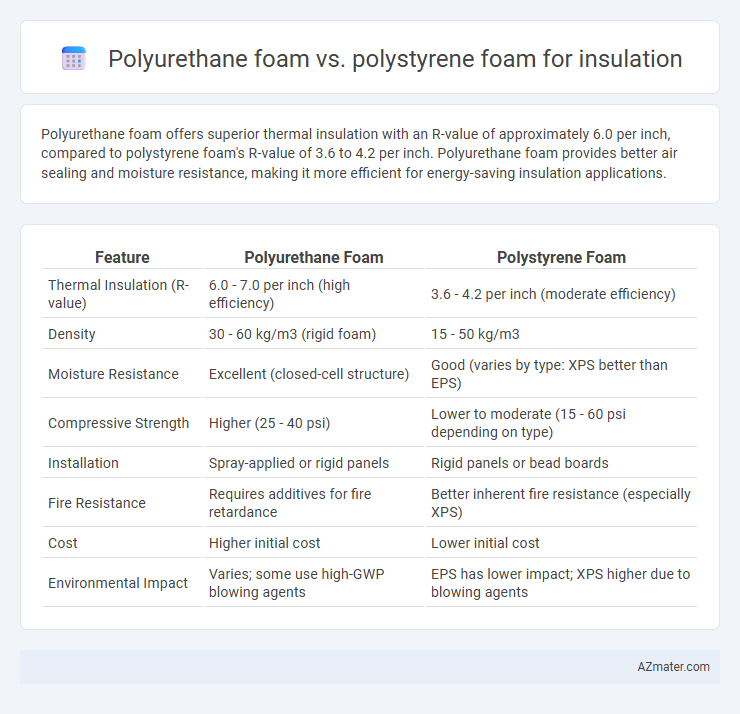Polyurethane foam offers superior thermal insulation with an R-value of approximately 6.0 per inch, compared to polystyrene foam's R-value of 3.6 to 4.2 per inch. Polyurethane foam provides better air sealing and moisture resistance, making it more efficient for energy-saving insulation applications.
Table of Comparison
| Feature | Polyurethane Foam | Polystyrene Foam |
|---|---|---|
| Thermal Insulation (R-value) | 6.0 - 7.0 per inch (high efficiency) | 3.6 - 4.2 per inch (moderate efficiency) |
| Density | 30 - 60 kg/m3 (rigid foam) | 15 - 50 kg/m3 |
| Moisture Resistance | Excellent (closed-cell structure) | Good (varies by type: XPS better than EPS) |
| Compressive Strength | Higher (25 - 40 psi) | Lower to moderate (15 - 60 psi depending on type) |
| Installation | Spray-applied or rigid panels | Rigid panels or bead boards |
| Fire Resistance | Requires additives for fire retardance | Better inherent fire resistance (especially XPS) |
| Cost | Higher initial cost | Lower initial cost |
| Environmental Impact | Varies; some use high-GWP blowing agents | EPS has lower impact; XPS higher due to blowing agents |
Introduction to Polyurethane and Polystyrene Foams
Polyurethane foam is a high-performance insulation material known for its excellent thermal resistance, moisture barrier properties, and versatility in spray or board form. Polystyrene foam, available as expanded (EPS) or extruded (XPS) types, offers durability, moisture resistance, and cost-effective thermal insulation commonly used in walls, roofs, and foundations. Both foams serve critical roles in energy-efficient building design by reducing heat transfer and enhancing indoor comfort.
Composition and Manufacturing Processes
Polyurethane foam consists of polyols and diisocyanates that react during a chemical foaming process, creating a closed-cell structure ideal for insulation due to its high thermal resistance. Polystyrene foam is produced by polymerizing styrene beads, which are expanded using steam to form either extruded (XPS) or expanded (EPS) foam with distinct cell structures affecting insulation performance and moisture resistance. Manufacturing polyurethane foam involves spray, pour-in-place, or rigid board methods, while polystyrene foam typically uses molding or extruding processes to achieve its final shape and density.
Thermal Insulation Properties Compared
Polyurethane foam offers superior thermal insulation properties with an R-value typically ranging from 6 to 7 per inch, significantly higher than polystyrene foam, which has an R-value of about 4 to 5 per inch. This higher R-value means polyurethane provides better resistance to heat flow, resulting in more effective energy savings and temperature control. Polystyrene foam, available in expanded (EPS) and extruded (XPS) forms, tends to have better moisture resistance, but its thermal performance is generally lower compared to the denser, closed-cell structure of polyurethane foam.
Moisture Resistance and Water Absorption
Polyurethane foam exhibits superior moisture resistance and significantly lower water absorption compared to polystyrene foam, making it ideal for humid environments and applications requiring airtight seals. Polystyrene foam, particularly expanded polystyrene (EPS), tends to absorb more water due to its open-cell structure, which can compromise its insulating properties and durability over time. Closed-cell polyurethane foam prevents moisture penetration effectively, thus maintaining thermal performance and structural integrity in insulation systems exposed to moisture.
Compressive Strength and Structural Integrity
Polyurethane foam offers superior compressive strength compared to polystyrene foam, making it more suitable for applications requiring higher load-bearing capacity. The closed-cell structure of polyurethane contributes to enhanced structural integrity and durability under pressure. Polystyrene foam, while lightweight and cost-effective, generally exhibits lower compressive strength and may deform more easily under sustained loads.
Fire Resistance and Safety Considerations
Polyurethane foam offers superior fire resistance compared to polystyrene foam due to its ability to char and self-extinguish when exposed to flames, reducing the spread of fire. Polystyrene foam, while effective for insulation, is highly flammable and can release toxic fumes during combustion, posing greater safety risks. Fire-retardant additives and protective barriers are essential when using polystyrene foam to enhance its fire safety in building applications.
Environmental Impact and Sustainability
Polyurethane foam offers superior insulation efficiency with a lower global warming potential due to advancements in eco-friendly blowing agents, whereas polystyrene foam, though durable and moisture-resistant, often relies on petroleum-based resources and has higher end-of-life disposal challenges. Polyurethane foams typically have better thermal performance per inch, reducing overall energy consumption and carbon footprint in buildings, while polystyrene's slower degradation contributes to persistent environmental pollution. Sustainable insulation choices increasingly favor bio-based or recycled-content polyurethane formulations and polystyrene recycling programs to mitigate long-term ecological impacts.
Installation Methods and Practical Applications
Polyurethane foam offers superior adhesion and expands to fill gaps, making it ideal for seamless insulation in irregular spaces, often applied through spray foam techniques. Polystyrene foam, available as rigid boards, is typically installed using adhesives or mechanical fasteners, providing a cost-effective solution for wall sheathing, roofing, and subfloor insulation. Polyurethane's higher R-value per inch suits applications requiring compact insulation, while polystyrene excels in moisture resistance and durability for exterior insulation systems.
Cost Analysis: Polyurethane vs Polystyrene
Polyurethane foam generally has a higher upfront cost compared to polystyrene foam, but its superior R-value per inch offers better long-term energy savings and reduced HVAC expenses. Polystyrene foam, including expanded (EPS) and extruded (XPS) types, is more affordable initially but may require thicker layers to achieve comparable insulation performance, potentially increasing installation costs. Evaluating the total cost of ownership, polyurethane foam often proves more cost-effective over time due to enhanced durability and thermal efficiency.
Choosing the Right Insulation: Key Factors to Consider
Polyurethane foam offers superior thermal resistance with an R-value of approximately 6 to 7 per inch, making it highly effective for energy-efficient insulation compared to polystyrene foam, which has an R-value of around 3.6 to 5 per inch. Key factors to consider include moisture resistance, as closed-cell polyurethane foam provides excellent vapor barriers, whereas polystyrene foam tends to absorb moisture unless properly sealed. Cost, installation complexity, and environmental impact are also critical, with polyurethane generally costing more but offering better long-term performance and air sealing capabilities.

Infographic: Polyurethane foam vs Polystyrene foam for Insulation
 azmater.com
azmater.com